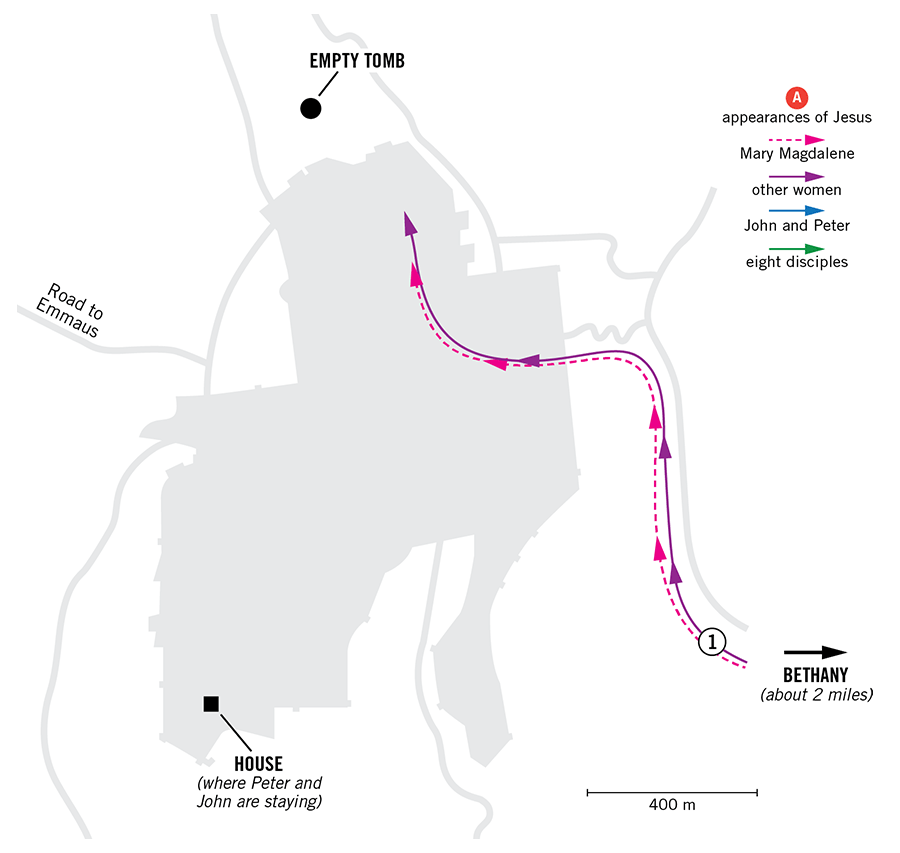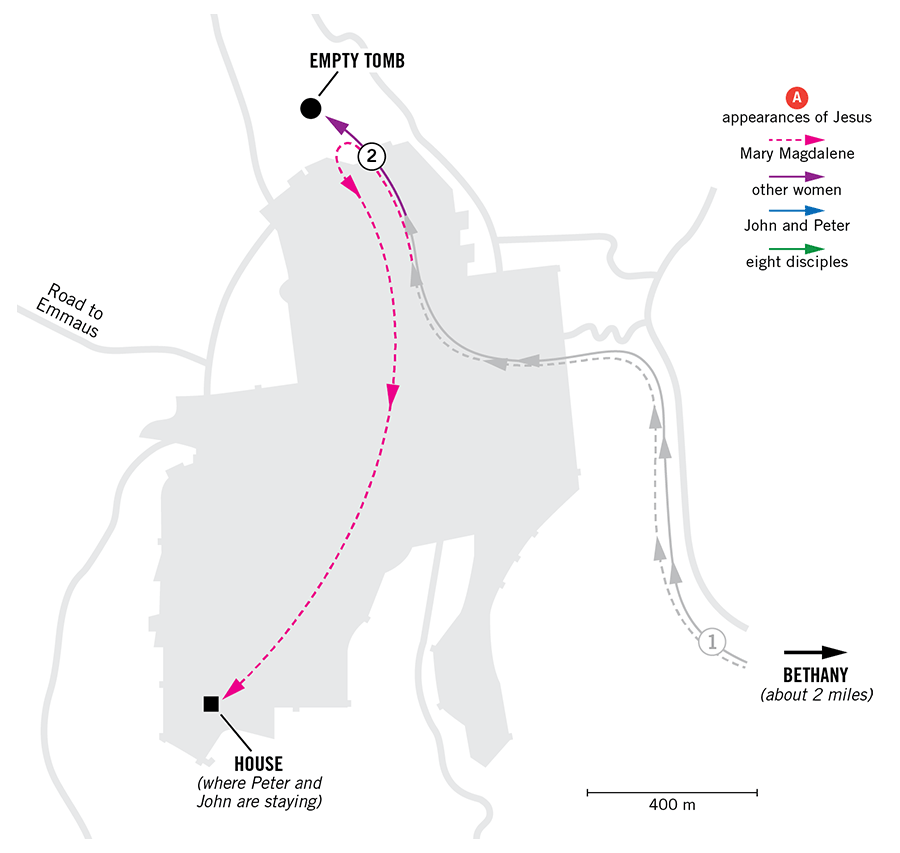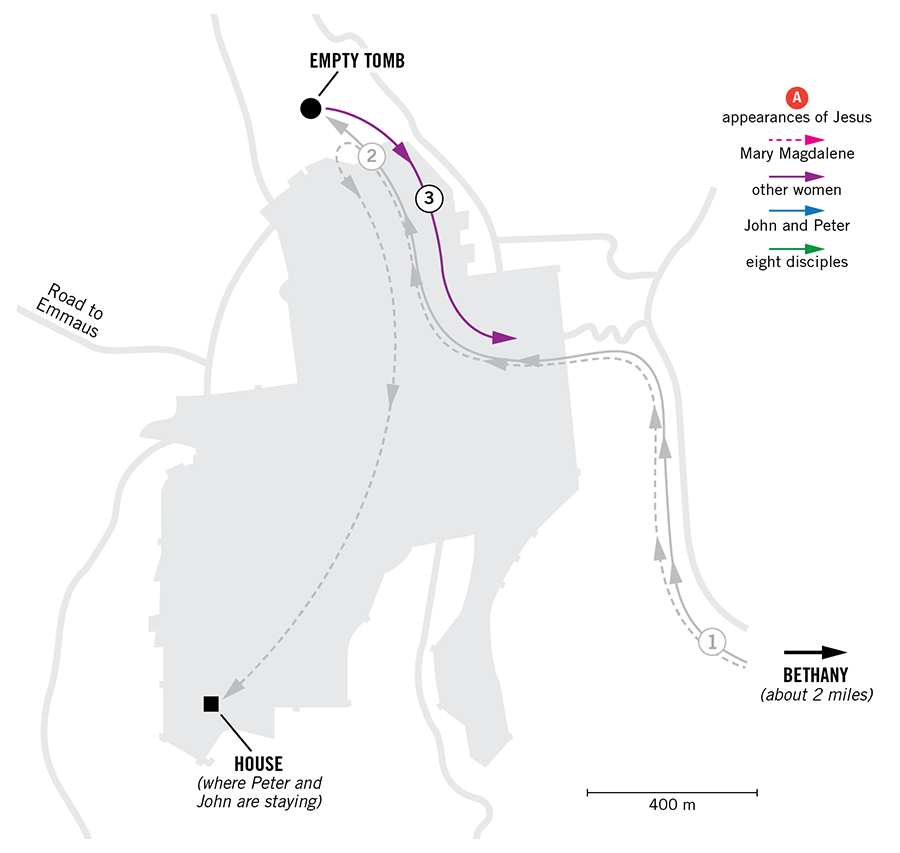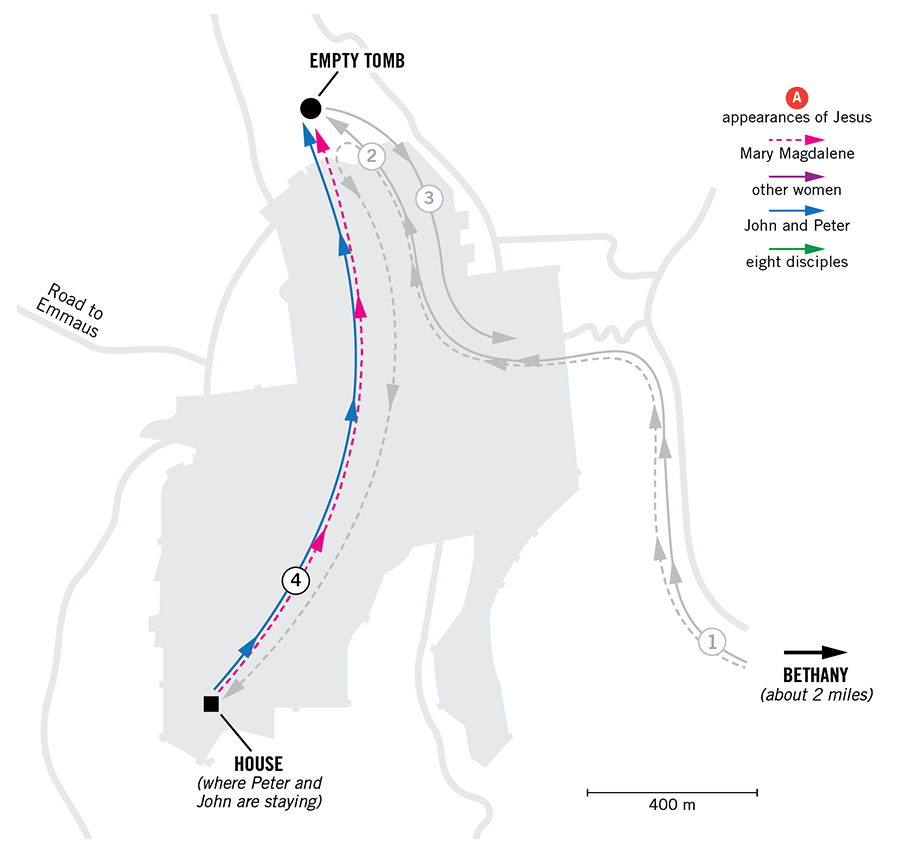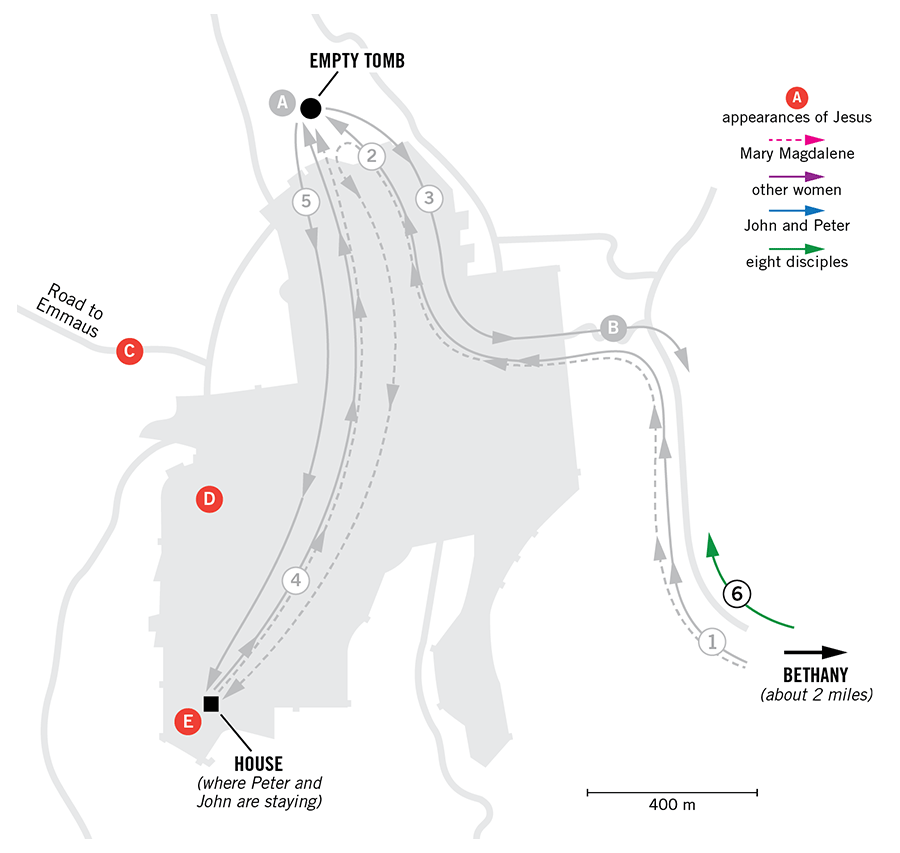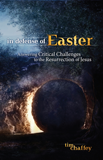
Christ’s Resurrection—Four Accounts, One Reality
Biblical Authority
Christ’s Resurrection led to a confusing day, as His followers raced around the city. Skeptics point to alleged contradictions to prove Scripture wrong. Can the four Gospels be reconciled?
The Gospels can’t keep their stories straight! How many women went to the tomb and when did they leave? How many angels visited the tomb? Did Jesus appear to all the women or just Mary Magdalene?
Actual contradictions in the Resurrection reports would raise serious concerns for Christianity. If these discrepancies are legitimate, they would be a strike against the preservation of Scripture, but errors would not prove anything against the truth of the Lord’s Resurrection or the infallible original records. Nevertheless, Christians need not worry. These accounts can be reconciled. Indeed, when we put all the pieces together, the wonder of the Resurrection shines out in even greater glory.
Early Morning
When did the women go to the tomb, and how many went?
The Gospels refer to different times and name different women who arrived at the tomb. Matthew states that “Mary Magdalene and the other Mary” came to the tomb as it “began to dawn” (Matthew 28:1). Mark adds Salome to the group and claims that they came “very early in the morning” (Mark 16:1–2). Luke agrees that it was “very early in the morning” and names “Mary Magdalene, Joanna, Mary the mother of James, and the other women” as those who came to the tomb (Luke 24:1, 24:10). John wrote that “Mary Magdalene went to the tomb early, while it was still dark” (John 20:1).
When we put all the pieces together, the wonder of the Resurrection shines out in even greater glory.
Regarding the timing of the women’s trip, the sticky point is John’s claim that they went to the tomb “while it was still dark” (John 20:1). Was it very early in the morning at dawn, or was it still dark? One plausible solution is that the phrases used in the Gospels all refer to the same general time. Much of the sky is still dark when the day begins to dawn very early in the morning.
Perhaps a better solution is that John may have described when the women initially left for the tomb, while the other Gospels described when the women arrived. If they lodged in Bethany, as they had done earlier in the week, then the women would need to travel about two miles to reach the burial site (John 11:18), plenty of time for the sun to rise.
Resolving the differences in the number
of women listed is straightforward.
At least five women went to the tomb,
since Luke names three of them and
then says “other women” went too (at
least two). Notice that Matthew does
not say that only two women were
there. Mark does not say only three
women were there. They simply focus
on the women they name. Although
John names only Mary Magdalene,
he is clearly aware that she was not
alone. Reporting to Peter and John, she
said, “They have taken away the Lord
out of the tomb, and we do not know
where they have laid Him
” (John 20:2,
italics added).
Was the tomb already open, and how many angels appeared?
Mark 16:4, Luke 24:2, and John 20:1
state outright that the stone had been
rolled away from the tomb prior to the
women’s arrival. Matthew’s wording
has caused some consternation. After
writing about the women going to the
tomb he writes, “And behold, there was
a great earthquake; for an angel of the
Lord descended from heaven, and came
and rolled back the stone from the door,
and sat on it
” (Matthew 28:2). Although this description follows his mention
of the women heading to the tomb,
Matthew does not claim that this
event occurred as the women arrived.
Instead, he provides helpful details
about what had already happened.
The angelic appearances have also drawn criticism. Was there one angel at the tomb, as described in Matthew 28:2–7 and Mark 16:5–7, or two angels, as stated in Luke 24:4–7 and John 20:12? This minor difficulty is easily explained. There were two angels. Neither Matthew nor Mark claims that only one angel was at the tomb. The complete number does not appear in their accounts. It is not a problem that Mark and Luke call the angels “men,” since angels frequently appeared in the form of men and were identified as such elsewhere (Genesis 18:1–2; Daniel 9:21).
Order of Appearances
The alleged contradictions already mentioned are relatively easy to reconcile, but resolving the diverse accounts given in the four Gospels and 1 Corinthians 15:5–8 concerning the post-Resurrection appearances is more difficult. None of these accounts mentions all of the Lord’s appearances, so the information must be pieced together from all five sources.
When and where did each woman see Jesus?
This is the most complex issue concerning the reporting of appearances.1 Matthew asserts that the women visited the tomb and saw an angel. While they were on the way to tell the disciples, Jesus appeared to them. There would be no difficulty here except that John has Mary Magdalene individually returning from the tomb to report to Peter and John that the body had been taken away. Only after her return to the tomb with the two disciples is she granted the privilege of being the first to see the risen Savior. So how can both accounts of women seeing Jesus be accurate? Many Gospel harmonies have been written, and there are a handful of plausible solutions. I believe the following scenario makes the best sense of the available data (see map).
As mentioned above, at least five women set out for the tomb in the early morning, probably from Bethany. As they neared the tomb, they noticed the stone had been removed. Apparently, Mary Magdalene left the other women to alert Peter and John. Based on her comment about not knowing the location of the Lord’s body, it seems that she was not among the women who encountered the angels at the tomb.
Meanwhile, the other women entered
the tomb and encountered
the angels. One of the
angels proclaimed that
the Lord had risen, and
then “the women went
out quickly from the tomb
with fear and great joy, and
ran to bring His disciples
word
” (Matthew 28:8–9).
So how could Jesus first appear to Mary Magdalene (Mark 16:9) and then to the other women? As they headed for the tomb, why didn’t Mary, Peter, and John cross paths with the other women who were going to tell the disciples?
The key to resolving these dilemmas is to understand that Peter and John were probably not staying in the same place as the other disciples. Remember, although all the disciples “forsook Him and fled” at His arrest (Matthew 26:56), Peter and John were brave enough to enter Jerusalem to find out what would happen to Jesus (John 18:15). Of course, Peter fled in shame at the rooster’s crow (Matthew 26:75), but John was present at the Cross (John 19:26). At some point, John and Peter met up, and they were likely staying together in Jerusalem when Mary Magdalene came to the door on Sunday morning.
Where were the other disciples, then? We cannot be certain, but they may well have stayed in Bethany. After all, this is where Jesus often stayed on trips to Jerusalem, and Bethany was on the eastern slope of the Mount of Olives (Mark 11:1), the location of Christ’s arrest.
If these suppositions are correct, then all of the difficulties are resolved nicely. Mary Magdalene first left the tomb and entered nearby Jerusalem to get Peter and John. During that time, the other women encountered the angels and then left the tomb to set out on the two-mile trip to Bethany to tell the other disciples. They may have stopped along the way to tell Clopas and an unnamed disciple about the morning’s events (Luke 24:22–24), or they may have split up so that a couple of them could inform these men. In all likelihood, “the wife of Clopas” was among these women (John 19:25).
Meanwhile, Peter, John, and Mary raced to the tomb. The men entered the tomb, saw the grave clothes, and then left. Mary stayed behind, weeping outside the tomb. When she looked into the tomb, she saw two angels (John 20:12), and after explaining her grief to them, she turned around and saw the Savior (John 20:16). After Mary departed to tell Peter and John about seeing the risen Lord, Jesus appeared to the other women who were on their way to Bethany (Matthew 28:9).
Three More Appearances on Sunday
The remaining appearances of Christ on that day are much easier to follow. Luke wrote about Clopas and a companion meeting the Lord while they walked from Jerusalem to Emmaus. They did not recognize Him until He broke bread with them (Luke 24:30–31).
They immediately returned to Jerusalem to share the good news with the disciples, who were gathered together without Thomas (John 20:19–24). Upon their arrival, they were told by the disciples that Jesus had appeared to Simon Peter (Luke 24:34; see also 1 Corinthians 15:5). It is unclear whether Peter saw Jesus before the two disciples saw Him on the road to Emmaus.
As they shared exciting details about the day’s events, Jesus appeared to the whole group. At first they were frightened, but the Lord showed them His scars and then ate some broiled fish and honeycomb (Luke 24:40–43).
Remaining Appearances
Jesus continued to appear to people over a forty-day period (Acts 1:3). Eight days after His Resurrection, Jesus appeared to the disciples again, and this time Thomas was present (John 20:24–29).
Over the next few weeks Jesus appeared to seven disciples at the Sea of Galilee (John 21:1–2). While still in Galilee, the disciples also saw Jesus on a hillside (Matthew 28:16–17). This may have been the event Paul mentioned where Jesus appeared to over 500 people at once (1 Corinthians 15:6). After that, Jesus was seen by His half-brother James, the son of Mary and Joseph (1 Corinthians 15:7).
The disciples returned to Jerusalem, where Jesus appeared to them a final time. He delivered the Great Commission, led them out to Bethany at the Mount of Olives, and ascended into heaven (Luke 24:50–51; Acts 1:9–11).2
Conclusion
Luke declared that after Jesus suffered and died on the Cross, He showed Himself alive “by many infallible proofs” (Acts 1:3). Skeptics will surely continue to question Scripture and neglect reasonable solutions to the dilemmas they propose. It’s hard for them to be open-minded about sensible answers because Christ’s Resurrection, if true, is a miracle that demonstrates Jesus is Lord—a truth contrary to their secular worldview, which rejects miracles and the supernatural. No matter how many objections unbelievers raise, Christians can be confident there are no contradictions in the Word of God.
Answers Magazine
April – June 2015
The eruption of Mount Saint Helens in the 1980s changed how we view catastrophe; on its thirty-fifth anniversary, we examine what we’ve learned since then.
Browse Issue SubscribeFootnotes
- Many of the difficulties related to the order of appearances are caused by Luke’s frequent use of telescoping, a common practice among historians that skip details and condense others. For more details on telescoping in the Resurrection accounts, please see my article at http://www.midwestapologetics.org/blog/?p=1417.
- Paul encountered Jesus a few years later on the road to Damascus (Acts 9:5; 1 Corinthians 15:8).
Recommended Resources

Answers in Genesis is an apologetics ministry, dedicated to helping Christians defend their faith and proclaim the good news of Jesus Christ.
- Customer Service 800.778.3390
- © 2024 Answers in Genesis


